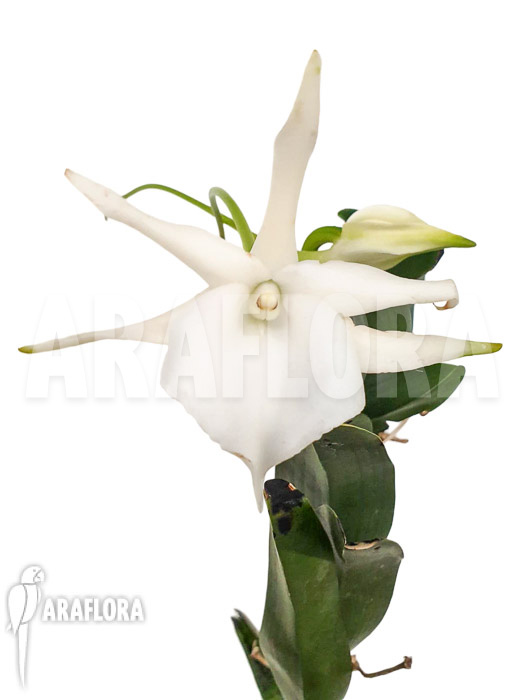Angraecum sesquipedale - Orchid599
Angraecum sesquipedale - Orchid599
Angraecum sesquipedale, also known as ‘Darwin’s orchid’, is a medium sized, warm to hot growing epiphyte from Madagascar. The large white flowers have an exceptionally long spur. This orchid could be grown in bright, warm greenhouses and indoors with special care.
Currently not in stock
€ 0,00
Keep me up to date?
Araflora will inform you as soon as the product is available again. Please fill in your e-mail address and we will let you know as soon as the product is back in stock. You will get an e-mail message when the product is available again. Unfortunately we cannot say how long this will be or what the price is likely to be.

Receive an e-mail when new stock of this plant arrives.
Share this plant? Press on one of the following icons.
Angraecum sesquipedale is a medium sized, monopodial orchid. The lanceolate, bended and folded leaves form a remarkable, fan-shaped pattern. During almost the whole year, flowers could form on a central, branched inflorescence. Per inflorescence, up to six waxy, long-lasting flowers could arise that produce a pleasant jasmine-like scent. Flowers are colored crème-white to white-green. The labellum has a clear bright white color. Each flower could reach an impressive size of 16,5 cm. The spur containing the nectar, could even reach an astonishing 35 cm. The size of the spur made Charles Darwin suggest that there must be a moth with a tongue this size to be able to pollinate this flower. After a broad array of skepticism and forty years later, when Darwin had already passed, scientists discovered this moth species. Propagation is done by separation of young plants and growing them separately.



Angraecum sesquipedale only grows naturally in the tropical rainforests of eastern Madagascar. This orchid grows as an epiphyte on skewed trees and mossy branches. For cultivating this species, provide warm temperatures between 25 and 30 degrees year-round. Temperature could drop a few degrees at night. Allow for a humidity of around 70 % or higher, and make sure this plant is given excellent ventilation. For a healthy and good flowering plant, give this species bright indirect light. Direct light in the morning or evening is acceptable. Pot this plant in a special mixture for epiphytes, consisting of a large part of bark chips and sphagnum moss. Water this orchid frequently, but not before the substrate is almost dried up completely. This plant does not have a dormancy period, although it grows slower in winter. Fertilize this species once every two weeks with specialized orchid fertilizer, according to the recommended dosage.





 7 cm
7 cm
 5 cm
5 cm












